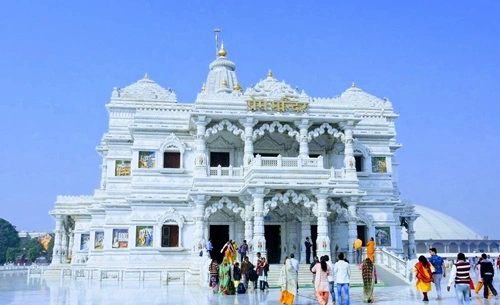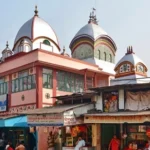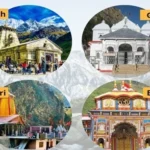Mathura, a small yet spiritually profound town in Uttar Pradesh, is famously celebrated as the birthplace of Lord Krishna. Situated on the banks of the Yamuna River, Mathura is a place where history, culture, and devotion come together to offer visitors a rich spiritual experience. As one of the seven sacred cities in Hinduism, Mathura holds immense religious significance and attracts millions of pilgrims and tourists alike. Knowing the best time to visit Mathura can make your journey truly memorable, as the city has unique experiences to offer in each season.

Exploring Mathura’s Spiritual and Cultural Landscape
Mathura’s importance in Hindu mythology stems from its association with Lord Krishna, who spent his early years here. The city’s temples, ghats, and vibrant celebrations capture the essence of Krishna’s life and teachings. Mathura’s main attractions include the Krishna Janmabhoomi Temple, where it is believed that Krishna was born, as well as Dwarkadhish Temple, Vishram Ghat, and a range of smaller yet beautiful temples dotting the town. With its annual festivals, colorful celebrations, and daily rituals, Mathura embodies the spirit of devotion year-round.
Best Seasons to Visit Mathura
1. Winter (October to March)
Winter is the most popular time to visit Mathura, as the weather remains pleasant and comfortable, with temperatures ranging from 8°C to 20°C. This season is ideal for exploring the temples and ghats without the exhaustion that summer’s heat can bring. The city’s charm is amplified by the clear skies and cool breezes, making it easy to roam the narrow streets, participate in aartis, and immerse yourself in the spiritual atmosphere.
One of the highlights of visiting in winter is the grand festival of Holi, celebrated in February or March. Mathura’s Holi is world-renowned for its vibrant and unique traditions, drawing tourists from across the globe. Devotees gather in massive numbers to celebrate with colors, music, and joy, particularly at the Dwarkadhish Temple and Banke Bihari Temple in nearby Vrindavan. Experiencing Holi in Mathura is a unique spectacle that showcases the city’s cultural richness and devotion, and it’s an experience that visitors treasure.
Additionally, other festivals like Makar Sankranti and Basant Panchami are celebrated with grandeur, giving travelers a chance to see Mathura’s cultural spirit in full bloom.
2. Monsoon (July to September)
Monsoon season in Mathura brings a fresh, lush vibrancy to the city as it gets rejuvenated by regular showers. While humidity levels can rise, the rain also cools down the temperature, making it more comfortable than the summer months. The ghats along the Yamuna River look especially scenic during the monsoon, and the temples, washed by the rain, acquire a special charm. Visiting Mathura during this season offers a more peaceful experience, as the tourist influx is generally lower, allowing for a more tranquil visit.
One of the main events during the monsoon season is Janmashtami, the festival celebrating Lord Krishna’s birth. This celebration, held in August, is one of the most significant events in Mathura. The city transforms into a hub of festivities, with grand processions, musical performances, and reenactments of scenes from Krishna’s life. Devotees from around the country and the world gather to witness the devotion-filled night of Krishna’s birth. Temples are adorned with flowers, and special ceremonies are held, making it a spiritually uplifting time to visit.
3. Summer (April to June)
Summer in Mathura can be intense, with temperatures often reaching above 40°C. While it may not be the most comfortable time to visit, summer offers a quieter and less crowded experience. If you’re comfortable with the heat, you’ll find it easier to explore temples and other attractions at a leisurely pace, as the tourist flow is significantly lower during these months.
An interesting aspect of visiting during summer is the celebration of the festival Akshaya Tritiya, typically held in April or May. This auspicious day is marked by prayers and rituals at temples across Mathura, and devotees believe it’s a powerful time for spiritual advancement. The quieter environment also allows visitors to spend more personal time in the temples and ghats, away from the bustling crowds.
Important Festivals and Events to Consider
To make your trip to Mathura truly enriching, plan it around some of the city’s major festivals, which showcase the cultural and spiritual legacy of this sacred city.
- Holi: Celebrated in March, Holi in Mathura is a vibrant event full of colors, enthusiasm, and traditional rituals. This is the peak season, and visitors should plan well in advance to find accommodations.
- Janmashtami: Held in August, Janmashtami celebrates Lord Krishna’s birth with special events across Mathura’s temples, especially at Krishna Janmabhoomi Temple. This celebration draws thousands of devotees, creating an atmosphere of pure devotion.
- Govardhan Puja: Celebrated a day after Diwali, this festival honors Krishna’s act of lifting the Govardhan Hill. It’s a joyful occasion filled with music, dance, and temple rituals.
Practical Tips for Visiting Mathura
- Timings: Most temples in Mathura open early in the morning, so visiting during sunrise provides a peaceful atmosphere and avoids peak hours.
- Dress Appropriately: Mathura is a deeply religious city, and respectful attire is recommended, especially when visiting temples. Traditional or modest clothing is preferred.
- Safety and Belongings: During major festivals, Mathura’s temples and streets can become very crowded. Keep your belongings secure and stay vigilant, especially in dense crowds.
- Nearby Excursions: Consider visiting nearby Vrindavan, another important spiritual site associated with Krishna’s early life. The temples and ghats here are equally captivating and only a short distance from Mathura.
- Local Cuisine: Don’t miss trying Mathura’s famous sweets like peda and lassi. Street food is also widely available, and tasting the local offerings adds an authentic flavor to the trip.
Conclusion
Mathura’s timeless allure lies in its spiritual depth, devotion-filled atmosphere, and vibrant traditions. Each season brings its own unique experience to this sacred town, whether it’s the colorful festivities of Holi, the devotional fervor of Janmashtami, or the quiet beauty of the monsoon months. By choosing the best time to visit according to your preferences, you can immerse yourself in the spirituality and cultural richness that Mathura has offered for centuries. Let the charm of Lord Krishna’s birthplace captivate you as you embark on a journey through one of India’s most revered cities.


